Lifestyle changes and the manufacture of super-efficient products are recognised as progressive measures in decoupling India’s development from greenhouse gas emissions. Appliances Standards and Labelling (S&L) is a proven policy instrument used worldwide that fosters cost-effective sustainable consumption and production. The Star Label issued in India by the Bureau of Energy Efficiency (BEE) endorsing energy-efficient appliances is now popular among Indian citizens and has been beneficial in reducing carbon dioxide emissions. In the previous article, India's energy standards and labelling mechanisms were examined in detail. This part of the series analyses the best practices implemented globally and discusses how these can be adopted in India.
India ranked 16 in the 2022 International Energy Efficiency Scorecard released by The American Council for an Energy-Efficient Economy (ACEEE). The ACEEE has examined the top 25 energy consumers in the world and allotted scores to each of these countries. The scorecard included various metrics, one of which is appliance standards and labelling (S&L). In ACEEE’s study, S&L programs in countries were given marks based on limited criteria, namely standards/labels requirement - mandatory or voluntary, total number of appliances under the Minimum Energy Performance Standards (MEPS) and labelling styles. The ranking does not provide valid insights into the S&L programs of these nations. For this article, to gain insights from India’s counterparts, a mapping of the S&L schemes of other countries with India’s scheme was conducted. Based on this comparative analysis, the following best practices are suggested to be adopted in India.
The option to incorporate more than 5 stars
Energy rating labels not only help consumers to make informed choices but also motivate producers to design and release more efficient innovative products into the market. A provision to incorporate more stars into the standard five-star rating can encourage manufacturers to keep improving the energy efficiency of appliances.
For example, in Australia, products with more than 6 stars are classified as 'super efficient' appliances. These appliances have an extra row of stars on the label.
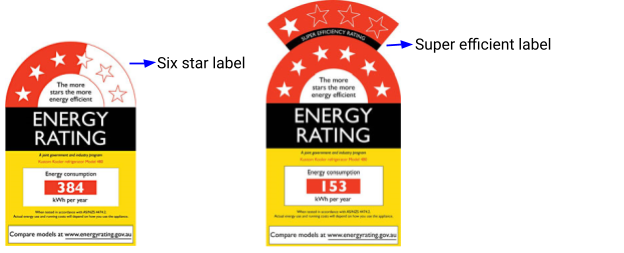
Australia’s energy labels | Source: energyrating.gov.au
QR code data carrier
Energy labels provide a clear and simple indication of appliances’ energy efficiency. Adding a Quick Response (QR) code on the energy label can ensure the authenticity of the labels used in the market. Using the code, labels can be verified by enabling the consumer to access and check the technical specifications displayed on the star label affixed on an appliance with ease from a database. The QR code will also make it easier for consumers to pick the most energy-efficient product. Consumers can get additional, official information like intuitive pictograms, to compare products and make a better informed purchase choice by scanning the code on a smartphone. QR codes are already present in labels like that of the European Union (EU) and China. The Bureau of Energy Efficiency (BEE) is also planning to implement QR codes on Indian labels to support authenticity and transparency, and restrict misuse.
The online platform that is accessed by the consumers via the QR code can provide additional information other than that mentioned on the energy labels such as:
- The product’s eco-design/manufacturing, durability and environmental sustainability
- Repairs, replacement and recycling options
- Seasonal energy consumption
- Energy efficiency tips and ways to use the product
- Updates on government policy and testing data in layman’s terms
Providing such information will promote today’s much-needed circular economy by scaling up the manufacture of sustainable products and motivating consumers’ participation.
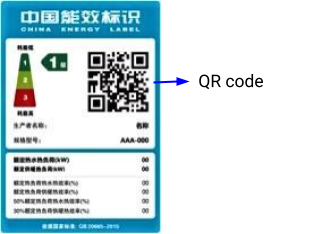
China’s energy label with a QR code | Source: China Compulsory Product Certification
Standards/Codes for standby power loss
Standby power is the electricity consumed by the appliance when it is switched off or not performing its primary function. According to reports, standby power loss is growing rapidly across the globe. To tackle this, the EU and countries like South Korea have introduced mandatory schemes to promote the design of automatic standby mode. In Korea, according to the ‘e-Standby Power’ program, products that meet the standard of standby loss below 1-Watt bear the ‘Energy Saving Label’ and those that fail to meet the standard bear the ‘standby power warning label’.
Both the labels - the energy-saving label and the warning label are great exemplars to be adopted in India.

South Korea’s ‘e-standby power program’ labels | Source: Korea Energy Agency
Information about the energy performance of appliances for different climatic zones
Appliance performance, especially the performance of heating and cooling appliances varies depending on the ambient temperature of a place. In India, the energy performance rating for air conditioners (AC), a mandatory-labelled appliance, is already issued according to the Indian Seasonal Energy Efficiency Ratio (ISEER) grading system that was developed based on the Indian average weather range. However, considering India’s diverse environmental and climatic conditions, it is suggested to incorporate similar grading for other common heating and cooling electronics used viz. refrigerators and water heaters. Furthermore, mentioning the performance of appliances for different climatic conditions on their labels similar to Australia’s ‘zoned energy rating label’, can help consumers select an appliance that performs best in their location.
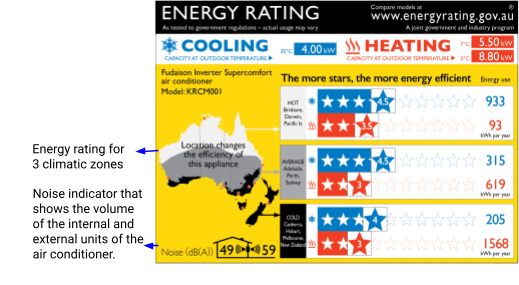
‘Zoned Energy Rating Label’ of Australia | Source: energyrating.gov.au
Noise emission indicator
The Australian and the European Union labels provide data on noise emitted by the appliance (in decibels (dB)). Studies have found that noisy appliances can negatively affect health and well-being. Yet, very little is being done to reduce the noise emitted by appliances. Enforcing noise level standards and labels will prompt the production of redesigned products and empower consumers to make informed purchases of quieter or noiseless appliances.
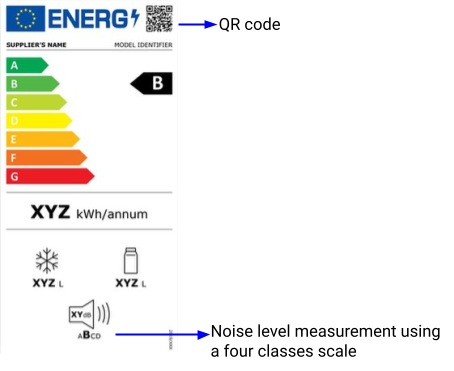
EU energy label | Source: European Commission
Energy consumption comparative scale
The annual energy consumption is already mentioned on the Indian star rating labels. However, it lacks a comparative scale with which consumers can compare it with other appliances in the same category. A good example of how this can be done is the ‘energy consumption indicator’ of the Canadian ‘EnerGuide’ label which positions the model compared with the most efficient and least efficient models in the same category. If the current format of the Indian energy labels is upgraded, the comparative scale along with the star rating will give consumers an explicit indication of the appliance's efficiency compared to its similar kind.
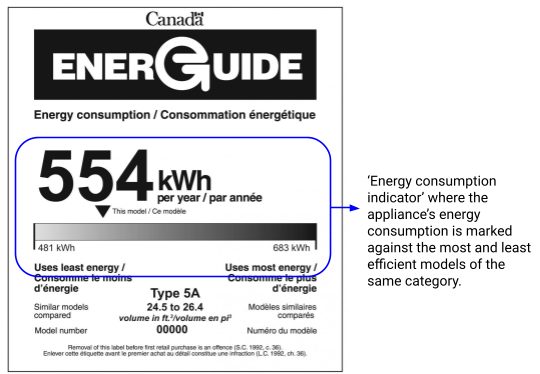
Canada’s EnerGuide label | Source: Government of Canada
Rules for the mandatory display of labels on e-commerce platforms
Online shopping is now one of the prevalent and preferred modes of shopping. In the European Union and South Africa, the manufacturers and resellers are obliged to provide the energy label information for internet sales. In India, the BEE provides instructions for a clear display of energy labels on end-use consumer electronics. However, it does not provide any specific instructions for e-commerce sites to display labels of the appliances on their platforms. As Indian consumers increasingly prefer to purchase their appliances online, it is necessary to make the display of labels prominently and consistently across e-commerce platforms mandatory.
Display status for appliances on e-commerce platforms | Source: Prayas
To sum up:
Access to affordable and clean energy is one of the sustainable development goals with the Standards and Labelling program in India proving to be an effective means of achieving this. This program has led to a saving of 70.57 billion units of power during 2021-22. An overview of the S&L regulations on a global scale gives us a broad scope of ideas to improve the program:
- Having an easy-to-understand label is key to the success of this program.
- Allowing recognition to highly efficient appliances by providing extra stars, will encourage companies to innovate.
- Using QR code data carriers that can direct users to a database with all the details can help promote the labels without compromising on the amount of information available.
- Showing standby power loss will give consumers a better idea of the energy efficiency of the appliance.
- Climate-based appliance performance ratings for different states of India must be given to ensure that the rating is accurate for people living in diverse geographical locations.
- Noise levels of the machine should also be provided on the label to enable the consumer to make an informed decision.
- A comparative energy rating scale showing the appliance against least and most efficient consumption will help consumers choose the right product.
- Regulations to enforce compulsory display of energy labels on e-commerce platforms must be implemented.
Add new comment